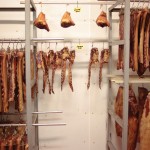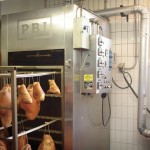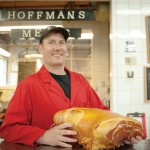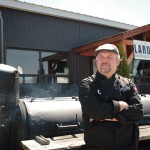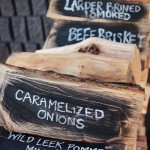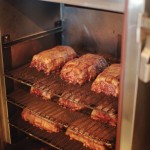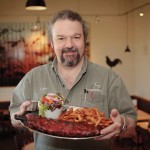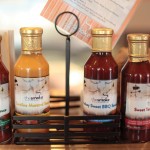Smoked food is as delicious as the art of preparing it is ancient
by Emily Worts ❧ photography by Kristie & Brenden Woods
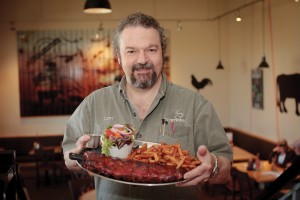
Cooking food with smoke is as old as fire itself and the concept isn’t a complicated one. Dig a pit, fill it with meat and hot coals, close it up and see what happens. Historically, not only did smoking tenderize meat while filling it with flavour, most importantly it preserved it. Today, top chefs are smoking meat purely for pleasure. Smoking food has seen a resurgence and it’s not only meat today’s chefs are smoking.
Cam Dyment, owner and chef of TheSmoke restaurant in Collingwood, which was recently showcased on the Food Network’s You Gotta Eat Here, is using his five smokers to prepare everything from smoked whitefish to smoked banana ice cream.
“I believe I have taken barbecue to a whole new level,” says Dyment. “Smoking burgers: I’m pretty sure I invented it.”
Dyment uses American lingo – referring to smoking as barbecuing and barbecuing as grilling – and because much of the smoking culture we see today originated in the BBQ belt of the U.S., including Texas and the Carolinas, he can be excused this transgression.
For Dyment, smoking is all about the flavour profile. First meat is marinated, then it is covered in a rub, next it is smoked, and finally it’s smothered in sauce.
“There are all these different levels of flavours,” he says. “You end up with four or five different profiles on a single item.”
Smoking can be done using all sorts of wood, including hickory and mesquite, each leaving its own trademark flavour in a piece of meat. Dyment uses hickory, believing it to be the most versatile and friendly to all the different products he smokes. Mesquite, though popular, he finds overpowering and therefore stays away from it.
Locally we have access to maple and applewood, and that’s what chef Gareth Carter of Men with Knives built his business on. When Carter opened up shop over a decade ago, it was with a traditional smoker on a trailer that he affectionately named the Applewood Express. Today applewood is becoming harder to find, especially wood that hasn’t been sprayed, and area chefs and butchers rely more on maple.
Men with Knives’ trademark smoker has ventured across the province preparing feasts at festivals, fairs and weddings while introducing customers to the flavour of smoke.
“It’s old fashioned and it’s cool,” says Carter of the Applewood Express, which can hold up to 150 pounds of meat at a time.
Like Dyment, Carter likes to experiment and have fun with his smoker. He has tried almost every type of protein you can think of. He has smoked giant coiled sausages in the forest, scallops for something special, staples like chicken wings and, out of curiosity, hard boiled eggs. After many tests and trials, his favourite thing to smoke is a local shoulder of lamb.
“Smoked lamb, now that’s something that really, really works,” he enthuses. However, he admits not everything has been a success.
“You know what doesn’t work, is a whole pig,” he says. “It looks like it got caught in a barn fire but inside its luscious.”
Michael Gerecke, owner of Hoffman’s Meats and European Deli in Stayner, relies more on tradition than experimentation to know what works and what doesn’t when it comes to smoking. His father Kurt established the business in 1975 and Michael, who took over in 2001, still uses his father’s recipes. To keep up with demand and government regulations Gerecke has had to update his equipment, but the product still tastes the same.
When Gerecke opens the door to his huge smoker you have to wait for the smoke to clear before you can see the 24 huge sides of bacon hanging from the racks. This smoker may be gigantic – it can hold 12 25-pound hams, but it isn’t big enough to meet demand. Gerecke’s customers are hooked on his traditionally smoked meats, something only a handful of butchers still do today. In fact many butchers send their meat to Hoffman’s to be smoked.
“In the busy season the smoker is working 24 hours a day,” says Gerecke. “I have to get up at midnight to check on the sawdust. It isn’t a fun job.”
For this reason Gerecke has ordered a brand new smoker from Europe, to work alongside his existing one. “Business has progressed so I can’t keep up with the smoker I have,” he says. “When the busy season comes I won’t have to work all night and day.”
To make room for the new smoker, Gerecke had to remove the traditional smoker his father built that was made of fire bricks with sawdust covering the floor.
“It was a plain Jane simple one,” says Gerecke of the old smoker that was “condemned” by the meat inspectors years ago.
The inspectors didn’t like the sawdust on the floor or the black tar on the walls, but some might argue this is where the true flavour comes from. Gerecke isn’t so sure. He says the bacon he produces from his new stainless steel smoker is just as good. The bacon is salt rubbed rather than pumped full of salt water (which you will find in most supermarket bacon) and it doesn’t shrink when you cook it. People come from all over to buy Hoffman’s bacon.
“People like to come here and buy our bacon because it is made the old traditional way and that’s what brings out the flavour,” says Don Forget, butcher at Hoffman’s. Forget has worked across the country as a butcher for the last 40 years, but he settled here because things are done a little slower, with a little more care put into the product.
“It’s a tradition,” says Forget of the way Gerecke prepares the meat at Hoffman’s. “You have to learn this type of thing when you’re little and it takes a long time to master it.”
Almost 50 per cent of Hoffman’s products are smoked – both hot smoked and cold smoked using maplewood sawdust. Hoffman’s smokes back bacon, prosciutto, pepperoni, ribs, chops, ham hocks, beef jerky, ham roasts, even roast beef. But Gerecke doesn’t just smoke pork and beef. In his cooler are boxes marked with customers’ names. In one box there are goose pepperonis that have been mixed with pork and smoked. People also bring in all sorts of wild game destined for the smoker.
“As long as it has a provincial stamp on it, I can smoke it,” Says Gerecke, who no longer slaughters meat but is happy to smoke meat that has been processed at a provincially recognized abattoir.
He has smoked moose, venison and goose, but refuses to work with bear. “It just never turns out,” he says. “We have our own system and if someone tries to change it, it screws everything up.”
Traditionally, smoking in the home was often done using a trap door in the upper chimney. The fire would be set on the main floor where the majority of the cooking would be done. Upstairs, in the attic, a trap door in the chimney meant you could hang meats to be smoked. For some, smoking has been taken from an efficient and cost-effective way to preserve meat to a somewhat pricey endeavour in search of the ‘perfect smoke’ flavour. Personal smokers can cost thousands of dollars and Gerecke warns that not everyone has the patience for it. He has had customers buy beautiful cuts of meat to take home and smoke, only to return to say they left it too long or they rushed it at too high a temperature.
Done right, smoking could easily be included in the global slow food movement. Gerecke smokes his bacon for 12 hours, Carter smokes his pork shoulder for 16 and everyone who knows anything about smoking will tell you it’s all about low and slow.
“People try and rush things but you have to have patience,” says Carter. “There really is a process. You have to feel it; you just know.”
And it’s not just the smoking that takes time. Gerecke pickles his meat for three days, Dyment prepares specific rubs for each type of meat (salt-based for beef, sugar-based for pork), and Carter is all about the sauces (many featuring local craft brews). This all adds up to a labour for flavour that can’t be replicated in any other style of cooking.
Smoking is elemental: fire and meat. But when these two ingredients are combined with patience and passion, something magical happens.
Smoking is unlike any other type of cooking and the proof is in the flavour. Because it works best with the ‘lesser’ cuts of meat – which are ribboned with fat that breaks down in the slow, low cooking process, adding flavour and tenderness – smoking doesn’t have to break the bank. Put the stainless steel smokers and the fancy enamel eggs to the side, pick up a shovel and start digging; you have just begun your own culinary adventure with smoke. ❧






